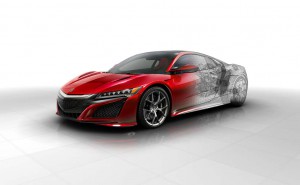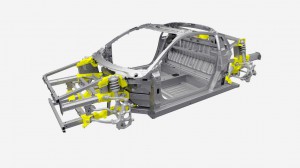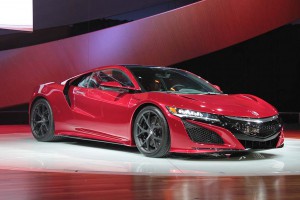While Acura pulled the covers off the reborn NSX at the Detroit Auto Show earlier this year, the maker held back on some key details. Now, it’s pulling back the skin of the supercar for the annual Society of Automotive Engineers World Congress.
Among other things, the Japanese maker has confirmed that its complex new hybrid drivetrain will use a twin-turbo 3.5-liter V -6 to allow it to balance performance and fuel economy. The 2016 NSX also will use what Acura is describing as a “multi-material spaceframe” to maximize body rigidity while minimizing weight.
“Our goal is to create something altogether new and exciting, something that advances the concept of a next generation supercar in the spirit of the original NSX,” said chief engineer and global development leader Ted Klaus. “In order to provide NSX-level value, we needed to push ourselves to experiment with, refine and then realize many new technologies.”
When the NSX was first introduced in 1990 it served as an example of what Honda and, in particular, its then-young Acura brand, could accomplish. By the time the two-seater faded from production in 2005, however, it seemed to underscore the loss of direction at the luxury brand.
(Click Here for coverage of the 2016 Acura NSX debut in Detroit.)
The new model is meant to put the same sort of halo around the Acura brand as the first NSX did a quarter century ago. But the two cars couldn’t be more different.
The 2016 NSX opts for a hybrid version of Acura’s Super-Handling All-Wheel-Drive system. The mid-mounted 3.5-liter V-6 is paired with a single electric motor to drive the rear axle. Two more motors are mounted up front, one for each wheel, allowing the car to electrically torque vector through turns – sending more power to the outer wheel to enhance cornering.
Acura still has not revealed final performance or fuel economy specs, though the combined system is expected to produce somewhere in the range of 550 horsepower. And that should mean one of the best power-to-weight ratios in the supercar realm.
(Ford drops bombshell with debut of its new GT “ultracar.” Click Here to check it out.)
Much of the new information released for the SAE convention focuses on Acura’s efforts to trim weight while maximizing body and chassis rigidity. The NSX uses what Acura claims is a “revolutionary” multi-material spaceframe. That includes the first application of a three-dimensionally formed ultra-high-strength steel A-pillar.
Lightweight aluminum is used for much of the rest of the spaceframe, though the maker turned to even lighter carbon fiber for the floor panel.
The NSX not only uses a unique mix of materials but also adopts new manufacturing processes. For example, a new ablation casting process helps enhance the function of the frontal crush zone.
A critical challenge with any state-of-the-art supercar is managing cooling, drag and downforce, and Acura told conference attendees it used a “total airflow management strategy” to pull this balancing act off. Unlike some supercars, Acura engineers chose not to go with any active aero components. But many key pieces of the NSX puzzle serve dual purpose.
The 2016 model uses 10 air-cooled heat exchangers for such components as the front motors, the twin-turbo V-6, the rear electric drive and the 9-speed dual clutch transmission. Three radiators serve the V-6 alone.
Airflow management helps minimize drag and, where needed, increase downforce, according to Klaus. Six vortices flow across the rear of the car, maximizing downforce, through the use of such features as lower rear diffuser fins that widen towards the back of the NSX.
Additional details are likely to dribble out as Acura prepares to bring the 2016 NSX to showrooms “later this year.”
(McLaren introduces “affordable” supercar with new 570S. Click Here for a closer look.)




Definitely a good in-depth look at the new car. I’m still a little hesitant about whether the Acura would be the best one for me, but it’s great that there’s a good resource to look at what it will have to offer.
Sounds like it will follow at least one Super Car tradition – that of being a service nightmare. A good friend of mine just bought a gorgeous 2002 Maserati for $15,000 because the owner was shown a $25,000 drivetrain problem when he took it in for routine service. (My friend is a doctor, but a car nut who is hands-on with cars as much as in the operating room). But if history is accurate, the NSX will see the lift for repairs much less often than most of its competitors.